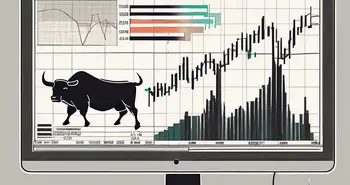All About Trading: A Comprehensive Guide to Mastering the Art of Trading

Trading is an art that requires skill, knowledge, and practice. Whether you are a beginner or an experienced trader, having a comprehensive understanding of the market is essential to succeed. In this comprehensive guide, I will take you through the basics of trading, the art of technical analysis, the science of fundamental analysis, and the development of a successful trading strategy. By the end of this guide, you will have the knowledge and tools to master the art of trading.
Understanding the Basics of Trading
Before delving deeper into the world of trading, it is important to understand what trading truly is and what it is not. Trading is not a get rich quick scheme, nor is it gambling. It is a disciplined approach to investing in the financial markets to generate profits. Trading plays a vital role in the financial market, providing liquidity and facilitating price discovery.
When it comes to trading, there are various factors that traders need to consider. One of the key aspects is market analysis. Traders use different methods and tools to analyze the market, such as technical analysis and fundamental analysis. Technical analysis involves studying historical price patterns and using indicators to predict future price movements. On the other hand, fundamental analysis focuses on analyzing the financial health and performance of companies to determine their intrinsic value.
In addition to market analysis, risk management is another crucial element in trading. Traders need to have a clear understanding of their risk tolerance and implement strategies to protect their capital. This includes setting stop-loss orders, which automatically sell a security when it reaches a certain price, limiting potential losses.
There are different types of trading strategies that traders employ, including day trading, swing trading, and position trading. Day trading involves buying and selling securities within the same trading day, taking advantage of short-term price fluctuations. It requires quick decision-making and the ability to handle high levels of volatility.
Swing trading, on the other hand, involves holding positions for a few days to weeks. Traders who employ this strategy aim to capture larger price movements and ride the momentum of the market. It requires patience and the ability to identify potential turning points in the market.
Position trading is a long-term strategy that involves holding positions for an extended period, ranging from weeks to months or even years. Traders who adopt this strategy focus on the long-term trends and aim to capture larger market moves. It requires a deep understanding of macroeconomic factors and the ability to withstand short-term market fluctuations.
Regardless of the trading strategy employed, traders need to continuously educate themselves and stay updated with market news and developments. The financial markets are constantly evolving, and traders need to adapt to changing market conditions. This involves staying informed about economic indicators, company earnings reports, and geopolitical events that can impact the markets.
In conclusion, trading is not just about buying and selling securities. It requires a comprehensive understanding of the financial markets, effective market analysis, risk management, and the ability to adapt to changing market conditions. By employing different trading strategies and continuously educating themselves, traders can increase their chances of success in the dynamic world of trading.
The Art of Technical Analysis
In the world of trading, technical analysis is a key tool utilized by traders to make informed trading decisions. Chart patterns and trend lines are fundamental aspects of technical analysis. By identifying patterns and trend lines on price charts, traders can predict future price movements and make timely trades.
One of the most commonly used chart patterns in technical analysis is the “head and shoulders” pattern. This pattern consists of three peaks, with the middle peak being the highest. Traders interpret this pattern as a reversal signal, indicating that the price is likely to move in the opposite direction. It is believed that the head and shoulders pattern reflects a shift in market sentiment, from bullish to bearish or vice versa.
Another popular chart pattern is the “double top” pattern. This pattern occurs when the price reaches a certain level, pulls back, and then reaches that level again, forming two peaks. Traders see this pattern as a sign that the price is likely to reverse its upward trend and start moving downwards. The double top pattern is often used to identify potential selling opportunities.
In addition to chart patterns, trend lines are also important tools in technical analysis. Trend lines are drawn on a price chart to connect the lows or highs of a trend. An upward trend line is drawn by connecting the higher lows, while a downward trend line is drawn by connecting the lower highs. These trend lines help traders identify the direction of the trend and potential support or resistance levels.
Furthermore, understanding technical indicators and oscillators is crucial in technical analysis. These indicators are mathematical calculations based on price and volume data, providing traders with valuable information about the strength and potential direction of a trend. One commonly used indicator is the moving average, which smooths out price data over a specific period of time and helps traders identify the overall trend. Another popular indicator is the relative strength index (RSI), which measures the speed and change of price movements to determine overbought or oversold conditions.
Volume analysis also plays a vital role in technical analysis, as it provides insights into market liquidity and the intensity of price movements. High volume during a price increase suggests strong buying pressure, while high volume during a price decrease indicates strong selling pressure. Traders often use volume analysis to confirm the validity of a trend or to identify potential trend reversals.
The Science of Fundamental Analysis
While technical analysis focuses on price patterns and indicators, fundamental analysis delves into the underlying factors that drive market movements. Economic indicators, such as GDP growth, employment data, and inflation rates, influence market sentiment and can significantly impact trading decisions.
Company financials are another critical aspect of fundamental analysis. By analyzing a company's financial statements, including revenue, expenses, and cash flows, traders can assess a company's financial health and make informed investment decisions. Market sentiment, which reflects the overall mood and attitudes of market participants, can also have a profound impact on trading. Understanding market sentiment can help traders anticipate potential market trends and adjust their trading strategies accordingly.
Developing a Successful Trading Strategy
Developing a successful trading strategy is not just about analyzing charts and financial statements; it also involves diligent risk management. Risk management is crucial in trading to protect your capital and minimize potential losses. Implementing stop-loss orders, setting risk-to-reward ratios, and diversifying your trading portfolio are some essential risk management techniques.
Having a trading plan is equally important. A trading plan outlines your trading goals, strategies, and risk tolerance. It acts as a blueprint for your trading activities and helps you stay disciplined and focused in the fast-paced world of trading.
Regularly evaluating your trading performance is also essential for long-term success. By reviewing your trades, identifying strengths and weaknesses, and making necessary adjustments, you can improve your trading skills and optimize your trading strategy.
Now, let me share a personal advice with you. When I first started trading, I was eager to make quick profits and often fell into the trap of impulsively buying and selling securities. However, I soon realized that successful trading requires patience, discipline, and a systematic approach. It is crucial to thoroughly research and analyze the market before making any trading decisions. Additionally, emotional control is vital. Emotions, such as fear and greed, can cloud judgment and lead to poor trading outcomes. By staying calm and sticking to my trading plan, I have been able to achieve consistent and profitable results in my trading journey.
FAQ
What is trading?
Trading is a disciplined approach to investing in the financial markets to generate profits. It involves buying and selling securities, such as stocks, currencies, and commodities.
What are the different types of trading?
There are several types of trading strategies, including day trading, swing trading, and position trading. Day trading involves buying and selling securities within the same trading day, while swing trading involves holding positions for a few days to weeks. Position trading involves holding positions for an extended period, ranging from weeks to months or even years.
What is technical analysis?
Technical analysis is a method used by traders to make trading decisions based on price patterns, chart indicators, and market trends.
What is fundamental analysis?
Fundamental analysis involves analyzing macroeconomic factors, company financials, and market sentiment to make trading decisions.
How important is risk management in trading?
Risk management is crucial in trading to protect your capital and minimize potential losses. Implementing risk management techniques, such as stop-loss orders and diversification, is essential for long-term success in trading.
What is the role of a trading plan?
A trading plan outlines your trading goals, strategies, and risk tolerance. It acts as a blueprint for your trading activities and helps you stay disciplined and focused in the fast-paced world of trading.
In conclusion, mastering the art of trading requires a comprehensive understanding of the basics of trading, the art of technical analysis, the science of fundamental analysis, and the development of a successful trading strategy. By acquiring the knowledge and skills outlined in this guide, you will be well-equipped to navigate the complex and dynamic world of trading. Remember, trading is not a guaranteed path to wealth, but with the right approach and mindset, it can be a rewarding and profitable endeavor.
As you consider the potential of stock trading and the broader cryptocurrency landscape, why not expand your investment horizon with Morpher? At Morpher.com, you can leverage the power of blockchain technology to trade across a multitude of asset classes, including cryptocurrencies, without the burden of fees or liquidity constraints. With the ability to engage in fractional investing, short selling, and up to 10x leverage, Morpher offers a unique and flexible trading experience that aligns perfectly with the innovative spirit of crypto mining. Take control of your investments with the safety of the Morpher Wallet and explore new market opportunities today. Sign Up and Get Your Free Sign Up Bonus to embark on a transformative trading journey with Morpher.

Disclaimer: All investments involve risk, and the past performance of a security, industry, sector, market, financial product, trading strategy, or individual’s trading does not guarantee future results or returns. Investors are fully responsible for any investment decisions they make. Such decisions should be based solely on an evaluation of their financial circumstances, investment objectives, risk tolerance, and liquidity needs. This post does not constitute investment advice.

Painless trading for everyone
Hundreds of markets all in one place - Apple, Bitcoin, Gold, Watches, NFTs, Sneakers and so much more.

Painless trading for everyone
Hundreds of markets all in one place - Apple, Bitcoin, Gold, Watches, NFTs, Sneakers and so much more.









